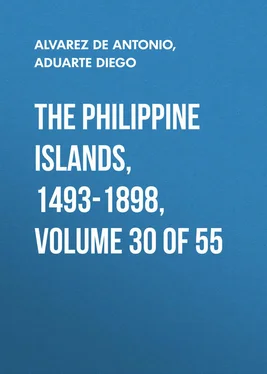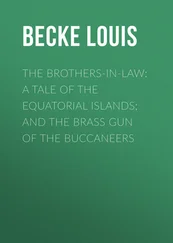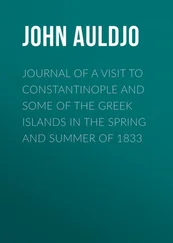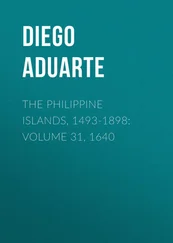Antonio Alvarez de Abreu - The Philippine Islands, 1493-1898, Volume 30 of 55
Здесь есть возможность читать онлайн «Antonio Alvarez de Abreu - The Philippine Islands, 1493-1898, Volume 30 of 55» — ознакомительный отрывок электронной книги совершенно бесплатно, а после прочтения отрывка купить полную версию. В некоторых случаях можно слушать аудио, скачать через торрент в формате fb2 и присутствует краткое содержание. Жанр: foreign_antique, foreign_prose, Историческая проза, на английском языке. Описание произведения, (предисловие) а так же отзывы посетителей доступны на портале библиотеки ЛибКат.
- Название:The Philippine Islands, 1493-1898, Volume 30 of 55
- Автор:
- Жанр:
- Год:неизвестен
- ISBN:нет данных
- Рейтинг книги:4 / 5. Голосов: 1
-
Избранное:Добавить в избранное
- Отзывы:
-
Ваша оценка:
- 80
- 1
- 2
- 3
- 4
- 5
The Philippine Islands, 1493-1898, Volume 30 of 55: краткое содержание, описание и аннотация
Предлагаем к чтению аннотацию, описание, краткое содержание или предисловие (зависит от того, что написал сам автор книги «The Philippine Islands, 1493-1898, Volume 30 of 55»). Если вы не нашли необходимую информацию о книге — напишите в комментариях, мы постараемся отыскать её.
The Philippine Islands, 1493-1898, Volume 30 of 55 — читать онлайн ознакомительный отрывок
Ниже представлен текст книги, разбитый по страницам. Система сохранения места последней прочитанной страницы, позволяет с удобством читать онлайн бесплатно книгу «The Philippine Islands, 1493-1898, Volume 30 of 55», без необходимости каждый раз заново искать на чём Вы остановились. Поставьте закладку, и сможете в любой момент перейти на страницу, на которой закончили чтение.
Интервал:
Закладка:
Chapter xix is devoted to an account of the Dominicans’ first mission-field, that of Bataán, and their labors therein. This field had been transiently occupied by other missionaries, but was so hard and barren that none of them had persevered in its cultivation. But the Dominicans “licked their fingers over the hardships,” and devote themselves most heroically to the care of these poor souls, and to learning their language – a difficult task for old men. One of them, Pedro de Bolaños, is overcome by the labors and privations of this sort of life, and is compelled to return to Manila, where he finally dies; and the others suffer much from illness. As soon as the fathers learn the language of those natives, they acquire great influence over the natives, especially through the confessional. They greatly abate drunkenness, the worst vice of the Indians, by “sending to Coventry” every intoxicated person; and they persuade the heathen to abandon their idols and superstitious practices, and even (perhaps the greatest triumph of all) to set free many slaves, and restore what they had taken from others in usury and by other unjust means. All this is accomplished within one year; and Bataán acquires a wide reputation for the religious and peaceful life which its natives lead. Various marvelous works are wrought for the fathers by divine power; “on the other hand, the devil played some tricks on them.” They have to encounter witches and devils, but the Lord gives them the victory over these evil beings.
Pangasinan is another mission-field assigned to the Dominicans, which also had been barren of gospel fruit through the obstinate hostility of its natives to the Christian faith. At first, they try to drive away the Dominicans also, but the holy lives of those fathers work a miracle in their hard hearts, and convert them to the faith. This is told in a letter from Bishop Benavides to the pope, written in 1598. He relates their hardships, patience, and devotion, in the face of the hatred and hostility of the natives – so bitter that the missionaries are entreated, not only by Spanish officers but by Bishop Salazar, to leave Pangasinan. But they refuse to go, and finally their persistent and unwearied kindness to the Indians, and their consistent Christian characters, soften those hard hearts; and, after three years of patient waiting, the fathers gather a rich harvest of souls. Those Indians are excellent Christians, and show most edifying devotion and piety, a statement thoroughly confirmed by later reports. The early persecution of the missionaries is explained by the fact that after their arrival the oracles of the native idols became silent, and by false accusations which the devil and his emissaries concoct against the religious. The conversions and pious acts of two prominent chiefs are related, as well as various miracles which occur in this mission.
The leading events and persons of the next mission (1588–89) are described. Amid the greatest difficulties and dangers, those religious make the perilous voyage to Manila. The first provincial chapter-meeting is held in that city, on June 12, 1588; on this occasion the new province is organized, and officers regularly elected. Some progress is made this year in Pangasinan; but some of the natives are obstinately hostile, and the missionaries are often ill-treated, and sometimes in danger of death. Their acts of charity to the Indians, and especially their success in curing some sick persons, gradually win the affection of the natives; and the fathers are able to do much to improve the condition of those people – above all, in furnishing them hospitals and medical care for the sick, thus saving many lives.
Soon after reaching the islands the Dominicans also undertake to minister to the Chinese who come to Manila. In this field, as among the Indians, they obtain a foothold by their generous and unwearied care for the sick; and soon they erect a hospital for the care of poor Chinese sick persons, which rapidly increases in size and in the aid bestowed upon it, and where nearly all the patients are converted before they leave it. One of their converts devotes himself to the service of the hospital for many years, and greatly aids the fathers in charge of it. New buildings are erected, and the number of converts is greatly increased. The village of Binondo is enlarged, and a large and beautiful church is erected, for this Chinese Christian population. The pious works of several of these converts are related.
The harvest of souls continues to increase, and in 1589 a small but helpful reënforcement of missionaries arrives at the islands. A full account is given of their labors in Pangasinan and Bataán, the marvels wrought for them, the renunciation of idols by the heathen, the devotion and piety displayed by the converts. Fathers Castro and Benavides go to China (1590) to attempt the establishment of a mission there; but their enterprise is a failure, on account of the Chinese hostility to foreigners. Juan Cobo, acting provincial during Castro’s absence, visits the missions and makes some arrangements for their more advantageous management. Excellent crops for several years, and the advice and aid of the missionaries, increase the temporal prosperity of the Indians; and they become more friendly to the religious, and more inclined to receive religious instruction.
Gomez Perez Dasmariñas arrives at Manila in 1590, as governor of the islands. Dissensions soon arise between him and Bishop Salazar, and the latter departs for Spain (in June, 1591), accompanied by Benavides. The governor is afterward slain by his own Chinese oarsmen. In April, 1592, Fray Alonso Ximenes is chosen provincial; the various missions are apportioned, and certain ordinances for their conduct and the better government of the province are enacted. Fray Juan de Castro and Fray Juan Cobo die soon afterward, of whom Aduarte presents full biographical accounts. A special assembly of the religious is convened in December, 1594, at which additional rules for their conduct are adopted. They are also asked to send religious to Nueva Segovia, for which mission two fathers are allotted. Aduarte describes that province, and its conquest (1581) by the Spaniards, to prevent it from becoming a Japanese possession. The Indians of that province are so warlike that for a long time the Spaniards can keep but a precarious hold upon it; and the friars find that they can accomplish nothing there with either Spaniards or Indians. The Dominicans, therefore, enter (1595) upon a hard and sterile field; but a considerable reënforcement of missionaries opportunely arrive to aid them, although many die while en route from España. Aduarte recounts the superstitious beliefs and observances current among the Cagayán Indians, notions which shape or modify nearly all of their social customs; they are, from his standpoint, slaves to the devil in all things. The Dominican missionaries, now eight in number, plan and begin the spiritual conquest of Cagayán. For nearly a year they endure, on account of the hostility of the natives, great sufferings from hunger, exposure, and apparently vain efforts; but gradually they subdue the natives by their unwearied self-denial, patience, and love. Their first-fruits consist in eight converted chiefs, who are baptized at Easter (1597), and these are the beginning of a rich harvest – at first, mainly of children baptized before they die from the prevalent epidemic of smallpox. Gradually, they are able to build churches in the respective villages, and to introduce among the Indians a civilized and Christian mode of life. At the time of Aduarte’s writing (ca. 1637), those people have become very fond of their religious, and ask for them to come to teach them – even changing their own residences, when necessary for their obtaining religious instruction. The supply of missionaries for that region is very inadequate, and should be promptly increased.
Читать дальшеИнтервал:
Закладка:
Похожие книги на «The Philippine Islands, 1493-1898, Volume 30 of 55»
Представляем Вашему вниманию похожие книги на «The Philippine Islands, 1493-1898, Volume 30 of 55» списком для выбора. Мы отобрали схожую по названию и смыслу литературу в надежде предоставить читателям больше вариантов отыскать новые, интересные, ещё непрочитанные произведения.
Обсуждение, отзывы о книге «The Philippine Islands, 1493-1898, Volume 30 of 55» и просто собственные мнения читателей. Оставьте ваши комментарии, напишите, что Вы думаете о произведении, его смысле или главных героях. Укажите что конкретно понравилось, а что нет, и почему Вы так считаете.












